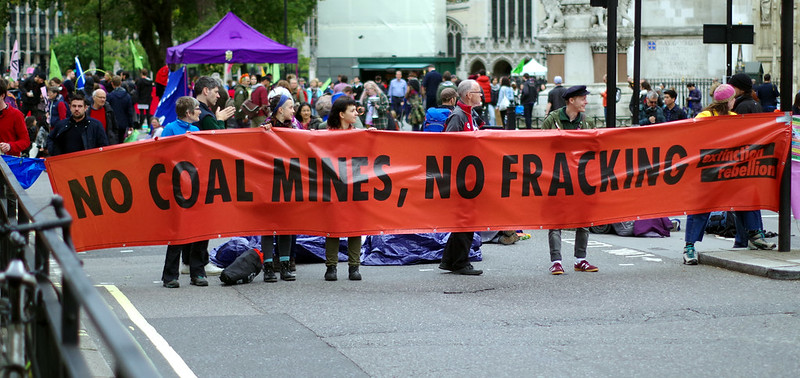Briefing
Towards a fossil fuel non-proliferation treaty
A new approach is needed to tackle the climate crisis, in which the long overlooked
supply-side of fossil fuels takes centre stage. A crucial aspect of this...
Electricity fuelled by coal is experiencing a record decline. 2019 is expected to show the biggest fall yet, after decades of increases. An accelerated move away from coal is imperative to achieve the goals of the Paris agreement. Coal currently accounts for 38.5% of the global power mix and generates 46% of global CO2 emissions. But, the pace of decline across a whole series of countries, although variable has been remarkable. An increasing number of wealthy countries in the G7 and OECD groups are close to completing a phase out of coal during the next decade. The United Nations Secretary-General António Guterres said in 2019 that he will call on leaders to stop subsidising fossil fuels and wants countries to build no new coal power plants after 2020.
The UK presents a leading example: once the cradle of the Industrial Revolution, with factories, railway transportation and street lighting all fuelled by coal, the UK will now be the first major economy to phase out coal completely. Recent proposals for new coal mines in the UK have attracted significant attention and protest, but such proposals are marginal in the context of how energy generation in the UK has changed rapidly.
The closure of UK coal-fired power stations is estimated to save around 25 billion tonnes of CO2 from being emitted. Various milestones indicative of momentum towards coal phase out have already been passed. The UK’s former Labour government implemented a policy of ‘no new coal without CCS’ in 2009 and when, in 2008, the UK faced a wave of proposals for new unabated coal plants, all were cancelled, leaving just seven coal plants in operation after March 2016. The last three deep mines all closed during 2015 and specific announcements have been made to phase out coal by 2025.This includes the closure of the last operating coal fired power station in Scotland. It would have included the closure of the last operating deep coal mining colliery in the UK, but for the recent approval in Cumbria of the first new deep coal mine for 30 years. The £165 million facility, Woodhouse Colliery, owned by West Cumbria Mining (WCM), plans to extract 2.5 million tonnes of metallurgical coal each year. Meanwhile, in 2016 renewables produced more electricity than coal, and the UK experienced its first coal free day since the 1880s, as a result of the impressive growth of renewables.
Shifts in industrial strategy have also taken place in other countries at high speed – over the course of about a decade – and despite the lobbying of an industry whose power and influence is often out of all proportion to its value to the economy. The US, Spain, Netherlands, Czech Republic and Poland have already undergone significant transitions away from coal mining. Finance has played a key role in this story, as investors have become concerned about stranded assets, seeking instead to capitalise on opportunities in renewable energy. Likewise, pension funds and multilateral and bilateral development funds have sought to divest from coal and governments have started to divest sovereign wealth funds from coal. The International Energy Agency’s 2019 world investment report, reveals a collapse in Final Investment Decisions (FIDs) for coal plants, which have tumbled by 75 per cent in three years. A total of 236 gigawatts of coal plants are under construction worldwide, but this is set to plummet. In 2015, FIDs signed off 88 gigawatts for construction, but this fell to 22 gigawatts in 2018. These financial trends have been combined with bold government leadership wanting to exploit other energy sources such as nuclear, fracking, gas and renewables.
Globally, the picture remains a challenging one with ongoing coal use and plans for expansion in rapidly growing economies such as India, China and South Africa. Coal demand is expected to grow again in 2018 and coal kept its share in the power mix at 38% after some years of decline. There is a note of warning, however, as illustrated by the environmental organisation 350.org’s recent report on foreign-led financing of coal power stations in Bangladesh. As one of the nation’s most likely to suffer from sea-rise, Bangladesh is being exploited by wealthier nations off-shoring their dirty fuel use. The report revealed plans for 29 coal-fired power stations, an expansion that has seen Bangladesh leap, within just 3 years, from 12th to 6th in terms of global coal power under development. If built, these plants would increase the country’s existing coal capacity 63-fold, from 525MW today to 33,200MW. Other sites where coal power facilities are receiving foreign financing – often through development banks – include Vietnam and Zimbabwe. Rapid Transition Alliance members Stand Earth also drew attention to richer nations’ imports from manufacturing sites reliant on coal in their campaign #FilthyFashion.
The example of the UK is interesting because it was first in and first out of coal.. Of course coal is also just one of the fossil fuels that needs to be left in the ground and there have been calls for a generic Fossil Fuel Non-Proliferation Treaty.
It will be important to establish principles to guide the orderly and just transition away from fossil fuels that takes into account historical contributions to climate change, capacity to change and levels of development need. If these principles are combined with the idea of sequencing, what this means in practice with regard to coal is that ‘only a few countries whose coal industry is currently material: a truly global sequence is unnecessary, greatly simplifying the process of agreement’. These countries are China, USA, India, Australia, Russia, Germany, Poland, Indonesia, and South Africa. Though they differ hugely on all three criteria, in weighting the three criteria—income, current emissions, and past cumulative emissions—a fairly clear sequence of action would emerge. The US, Australia and Germany can readily be identified as the first movers. The next group is probably Russia and Poland, both upper-middle-income countries with a long history of high carbon emissions. After them come China and South Africa, followed by Indonesia and India.
The UK example also illustrates the importance of a just transition in these previously vital industries, which are geographically concentrated and whose closure has caused great hardship and social deprivation across multiple generations. The number of jobs in the UK coal economy dropped from 221,000 in 1985 to just 7000 in 2005. The issues about the future of communities situated near coal facilities dogged this period and continue to be raised, for example in the responses to the 2016 UK coal consultation. The miners strikes were socially divisive, politically formative and left a deep wound in the country’s psyche – north against south, rich versus poor, blue-collar versus white collar. Other nations would do well to avoid this pain by planning the withdrawal and fairly offering new opportunities and incentives to those communities hardest hit.

The UK was also forced to accept early on that technology to capture carbon effectively from coal use was simply not available – and would not be ready in time. In the mid-2000s the owners of the UK’s remaining coal power plants faced the challenge of advancing plant age, relative inefficiency, and impending environmental regulations (Littlecott et al 2018). 2008 saw the passage of the UK’s Climate Change Act which provided the basis for formal advice to government from the new Committee on Climate Change (CCC) and the introduction of multi-year carbon budgets. The Committee immediately advised that any new coal plants would need to retrofit and operate carbon, capture and storage (CCS) technology from the early 2020s. Despite the 2009 commitment to no new coal without CCS, ultimately no new coal power plants were built.
Recent research at Stanford University in the US has backed up this position, proving that the social cost of carbon capture—including air pollution, potential health problems, economic costs and overall contributions to climate change— are always similar to or higher than operating a fossil fuel plant without carbon capture, and higher than not capturing carbon from the air at all. Even when the capture equipment is powered by renewable electricity, the study concluded that it is always better to use renewable electricity to replace coal or natural gas electricity or to do nothing, from a social cost perspective.

The UK’s withdrawal from coal use has been in stages and can be set against the backdrop of the great London Smog disaster of 1952, which caused over 4000 excess deaths, caused public outrage that damaged coal’s status.
It reinforced the public perception that coal was old-fashioned, dirty and outdated. The anti-smoke movement used the incident to increase pressure on politicians which ultimately led to the Clean Air Act (1956), which restricted coal use in people’s homes. By 1970, the number of premises covered by smoke control orders had grown to 4.5 million.When Margaret Thatcher was elected Prime Minister in 1979, British coal mines employed over 200,000 people and produced over 100 million tonnes of coal a year. In the 10 years after the 1984–5 miners’ strike, which is considered a turning point in the UK’s social and economic history, employment by British Coal and the number of pits it operated fell by more than 90%. By the end of the 1990s, more than 95% of these jobs and 80% of coal production no longer existed.
Closures of coal facilities in other countries have similarly not been the result of climate policy on the whole. In the case of Poland, it was the collapse in demand for coal or the Czech Republic in the wake of the collapse of the Soviet Union, the inexorable rise of shale gas in the US, or the discovery of gas in the Netherlands. Progress toward a reduction in coal use continues to be patchy across the globe. As the IEA Coal report for 2018 puts it: ‘In a growing number of countries, the elimination of coal-fired generation is a key climate policy goal while in others, coal is abundant and affordable and remains the key source of electricity. For example, gross coal exports accounted for 15% of Australia’s gross merchandise exports 2015, and 6% of South Africa’s. However, the Chinese government is simultaneously making efforts to reduce coal use and to push for cleaner energy. China’s government plans to reduce coal power production in the north-west of the country by at least a quarter across the provinces of Qinghai, Gansu and Shaanxi, and the regions of Xinjiang and Ningxia. The three-year pilot project by the State-owned Assets Supervision and Administration Commission of the State Council, or Sasac, is expected to be the first in a multi-stage initiative to make coal production more efficient across the country.
Among G7 members, only Japan continues to pursue the development of new coal plants and we see some evidence above of a shift here too – although investment in other countries’ coal mining will continue as long as there is money to be made and its under the radar of domestic concerns. In Australia, coal-fired power generation currently still accounts for more than three quarters of electricity supply and the government has until now stood foursquare behind the coal industry, pushing for the opening of new mines – even at the expense of the Great Barrier Reef – and upping exports of coal to be burnt by other countries. These exports mean that Australia is already responsible for five percent of global greenhouse gas emissions, and this figure was forecast to reach a staggering 17 percent by 2030. However, the recent devastating fires are likely to increase pressure for energy transition and mechanisms for the retirement of coal-fired power stations.
Climate change policy has been supported – and even preceded – by financial pressure and a cascade of banks backing out of big coal projects. In Japan, a massive coal-fired power plant planned across the bay from Tokyo has been abandoned. Campaigners estimate the decision will avoid 12 million annual tons of CO2 emissions. Meanwhile in British Columbia, Canada, a planned coal port that would have shipped coal over to Asia to be burned was rejected, after years of protest. And two more coal plants that were the sites of local resistance were defeated in February this year in Turkey and Australia, where a stinging court judgement cited the carbon budget and climate change. Even in South Africa, a country heavily dependent on coal, a series of banks are walking away. Nedbank announced they’d stop funding coal altogether, then FirstRand Group quickly followed. Insurers are also retreating from the coal industry; a report by the group Unfriend Coal describes how the number of insurers withdrawing cover for coal projects more than doubled in 2019. For the first time, US companies have taken action, leaving Lloyd’s of London and Asian insurers as the “last resort” for fossil fuels.The report, which rates the world’s 35 biggest insurers on their actions on fossil fuels, declares that coal – the biggest single contributor to climate change – “is on the way to becoming uninsurable” as most coal projects cannot be financed, built or operated without insurance.
Coal is also often singled out for being first in the queue for managed decline because of a combination of its high emissions intensity, low rents per unit value, local environmental costs and sheer scale. At present 43% of carbon dioxide (CO2) emissions come from fuel combustion and nearly 25% of total CO2 equivalent emissions come from coal. CO2 emissions from coal are nearly twice those of natural gas and are 30-40% greater than for oil. It also involves relatively few players – although their concentration can make them punch above their weight politically. In the US, in 2016 coal mining accounted for just under 66,000 jobs compared to a total employment of 153 million, but these jobs are concentrated in a small number of regions. The power of Australia’s coal lobbies remains strong, even in the face of devastating wildfires and rising temperatures. They are small in number, capital-intensive, own highly specific assets, and are politically well-organized. Even in India, coal mining accounted for around 358,500 thousand direct jobs in 2012, out of a work force in the order of 490 million.
Reducing coal use benefits from clear-cut and observable outcomes in terms of localized pollution. For example, in Northern China, where exposure to high levels of particulates from coal burning reduced life-expectancy by an astonishing five years, is a powerful driver for change. Plus the health costs attributable to coal burning in Europe are estimated to run at between €15 and €40 bn per annum. Alternative energy sources, such as onshore and offshore wind and solar photovoltaics (PV), are also constantly improving in terms of cost competitiveness with coal in many locations. These alternatives also have important co-benefits, such as producing much less local air pollution that impacts human health, and using significantly less water. Improvements in the cost of energy storage and other approaches to managing intermittency–a common retort to the possibility of significant fossil fuel phase out–have also gathered pace.

Increasingly, coal has become un-economic and un-bankable in many parts of the world. This is not just about divestment where, for example, Norway’s sovereign wealth fund has divested from coal stocks, while Ireland’s Parliament has voted to require its sovereign wealth fund to divest from all fossil fuel stocks. Part of the story here is unsustainable levels of state subsidies. In Belgium, rising public pressure to end expensive subsidies was a key factor in the Government’s decision in 1986 to phase out coal mining at the nation’s five remaining collieries, all operating on a loss making basis in the Limburg province. And the cost of not supporting a transition can be much higher than the costs of the transition. For example, in the Spanish case, approximately 22 billion Euros is estimated to have been spent in government subsidies just on supporting the profitability of mining activities between 1992 and 2014.
